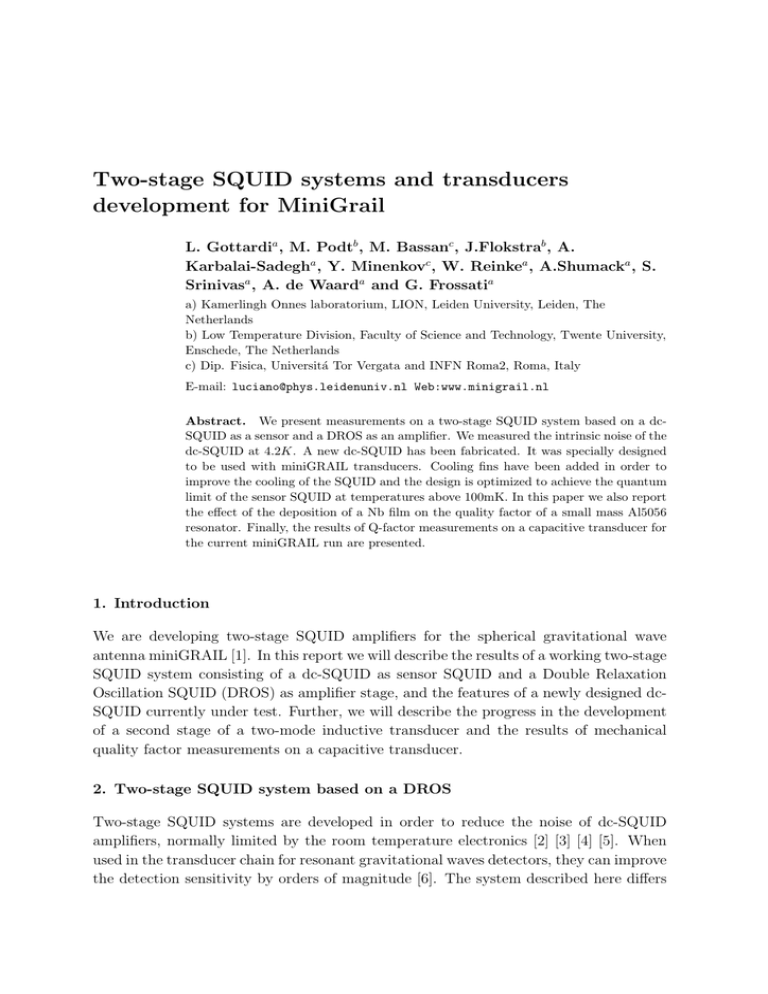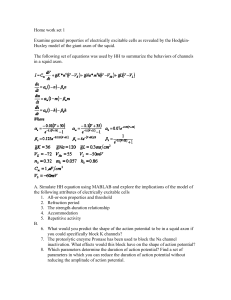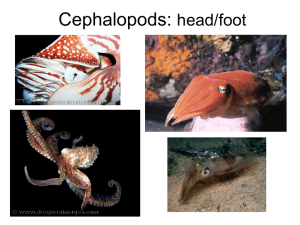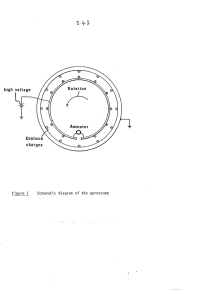Two-stage SQUID systems and transducers development for MiniGrail
advertisement

Two-stage SQUID systems and transducers development for MiniGrail L. Gottardia , M. Podtb , M. Bassanc , J.Flokstrab , A. Karbalai-Sadegha , Y. Minenkovc , W. Reinkea , A.Shumacka , S. Srinivasa , A. de Waarda and G. Frossatia a) Kamerlingh Onnes laboratorium, LION, Leiden University, Leiden, The Netherlands b) Low Temperature Division, Faculty of Science and Technology, Twente University, Enschede, The Netherlands c) Dip. Fisica, Universitá Tor Vergata and INFN Roma2, Roma, Italy E-mail: luciano@phys.leidenuniv.nl Web:www.minigrail.nl Abstract. We present measurements on a two-stage SQUID system based on a dcSQUID as a sensor and a DROS as an amplifier. We measured the intrinsic noise of the dc-SQUID at 4.2K. A new dc-SQUID has been fabricated. It was specially designed to be used with miniGRAIL transducers. Cooling fins have been added in order to improve the cooling of the SQUID and the design is optimized to achieve the quantum limit of the sensor SQUID at temperatures above 100mK. In this paper we also report the effect of the deposition of a Nb film on the quality factor of a small mass Al5056 resonator. Finally, the results of Q-factor measurements on a capacitive transducer for the current miniGRAIL run are presented. 1. Introduction We are developing two-stage SQUID amplifiers for the spherical gravitational wave antenna miniGRAIL [1]. In this report we will describe the results of a working two-stage SQUID system consisting of a dc-SQUID as sensor SQUID and a Double Relaxation Oscillation SQUID (DROS) as amplifier stage, and the features of a newly designed dcSQUID currently under test. Further, we will describe the progress in the development of a second stage of a two-mode inductive transducer and the results of mechanical quality factor measurements on a capacitive transducer. 2. Two-stage SQUID system based on a DROS Two-stage SQUID systems are developed in order to reduce the noise of dc-SQUID amplifiers, normally limited by the room temperature electronics [2] [3] [4] [5]. When used in the transducer chain for resonant gravitational waves detectors, they can improve the detection sensitivity by orders of magnitude [6]. The system described here differs 2 Two-stage SQUID systems and transducers development for MiniGrail Lf r I b Φ sig Φ sig Φ fb r R bias L sh R sh Lf I fb V bias Quantum Design dc-SQUID chip Vout Φ ref DROS chip Figure 1. Scheme of the two-stage SQUID system based on a DROS from other two-stage SQUIDs used in GW experiments since it uses a DROS as an amplifier SQUID [9]. A DROS has a large flux-to-voltage transfer function which allows direct read-out of the signal. The room temperature electronics can be highly simplified and the number of wires that need to be brought to the experimental space reduced. Both features are important when six transducers [8] will be used to read-out the spherical antenna. The two-stage SQUID system we developed is schematically described in figure 1 and is based on a configuration reported in ref. [2]. A standard chip manufactured by Quantum Design (QD) ‡ was chosen as first stage dc-SQUID because of a larger input inductance with respect to the dc-SQUID described in ref. [2]. A new dc-SQUID, specially designed for miniGRAIL, is currently under test. The dc-SQUID is biased at a constant voltage by means of a resistor Rbias = 0.27Ω. The current through the sensor SQUID is modulated by an applied signal flux Φsig and is fed through the input coil of the DROS. Inductances Lf are placed in series for the purpose of filter. The QD chip also has evaporated resistors between the SQUID and the connecting pads, which add a total resistance of 1Ω in series with Lf . RC filters are placed in parallel with the input coils of the dc-SQUID and the DROS to damp the internal resonances of the input coil. Both the dc-SQUID and the DROS are bonded on the same PC-board, which is fixed to a lead-tin plated copper support and enclosed in a Nb shield. The input coil of the sensor SQUID is connected by 50µm thick annealed Nb wires to Nb blocks for further connection to the transducer. An extra module with RF-filters for the feedback and bias lines of both the SQUIDs is connected outside the two-stage SQUID module. The main features of the dc-SQUID and the DROS are summarized in table 1. The energy resolution is commonly used to compare different SQUIDs, even if it is ‡ Quantum Design, 11578 Sorrento Valley Road, San Diego Two-stage SQUID systems and transducers development for MiniGrail Electrical parameter Lsq (pH) Ic = 2I0 (µA) βL = 2I0 Lsq/Φ0 Rshunt (Ω) Min (nH) Lin (µH) QD dc-SQUID 80b 16a 0.62 1.6a 10b 1.8b 3 DROS 550a 4 − 5a 1.1 47a 6.7a 0.15a Table 1. Parameters of the dc-SQUID and the DROS used in the experiment. a measured value, b nominal value. not enough to fully describe their properties. For a non-hysteretic dc-SQUID the energy resolution can be calculated using [7] SΦ 16kB T Lsq ǫ= ≃ 2Lsq R Ã 1 + βL 2βL !2 , (1) where SΦ is the flux noise spectral density, T is the temperature of the SQUID, R is the shunt resistance, Lsq the inductance of the SQUID and βL = 2I0 Lsq /Φ0 the screening parameter. The two-stage SQUID system is characterized by using home-made flux locked loop (FLL) electronics based on direct voltage read-out. Figure 2. a) V − Φsig curves of the two-stage SQUID for different bias currents of the first stage. The bias current of the DROS was fixed at Ib,2 = 20µA. b) Flux noise spectrum of the two-stage SQUID measured at 4.2K. The measured V − Φsig of the two-stage SQUID system is shown in figure 2(a) for different bias points of the dc-SQUID, while the DROS was constantly biased at a Two-stage SQUID systems and transducers development for MiniGrail 4 current Ib,2 = 20µA. The noise spectrum of the two-stage SQUID system measured in FLL mode at 4.2K is shown in figure 2(b). √ √ The total white flux noise is SΦ = 1.28µΦ0 / Hz and was obtained with bias currents of the first and second stage respectively Ib,1 = 140µA and Ib,2 = 20µA. This corresponds to an intrinsic energy resolution of ǫ = SΦ /2Lsq = 409h̄ and a coupled energy resolution of ǫcoupl = Li SΦ 2 /2Mi 2 = 534h̄. This is in good agreement with the theoretical prediction of ǫ = 441h̄ calculated from (1), where βL = 0.62 for the QD dc-SQUID chip under test. The flux-to-voltage transfer function at the best bias point is ∂V /∂Φ = 7.9mV /Φ0 and the flux gain between the two SQUIDs is G = 40. We are currently testing the two-stage SQUID system in a dilution refrigerator unit in order to measure its thermal noise in the mK range. The low temperature should improve the energy resolution by at least one order of magnitude and reduce the amplifier noise towards the quantum limit. 3. Fabrication of new dc-SQUIDs for miniGRAIL One of the main problems in reaching the quantum limit with dc-SQUID amplifiers is the cooling of the chip itself and of the shunt resistors. This becomes critical below 200 mK [3], [10]. We designed and fabricated new dc-SQUIDs with Pd cooling fins added to the shunt resistors as shown in figure 3. Figure 3. Micrograph (a) and scheme (b) of the sensors SQUIDs with Pd cooling fins (gray blocks) added to the shunt resistors. The design is optimized to achieve the quantum limit at temperature higher than 100 mK, while the cooling fins increase the contact area and reduce the hot-electron effect of the shunt resistors. The input coil is designed to have an inductance of the order Two-stage SQUID systems and transducers development for MiniGrail 5 of 1 µH to make it useful for gravitational wave detectors. These SQUIDs have been successfully fabricated and will be soon measured in a dilution refrigerator. 4. Q factor of a small mass Al5056 resonator We are planning to use a two-mode inductive transducer for the final configuration of miniGRAIL to increase both the sensitivity and the bandwidth [13]. Here we describe an experiment performed on the second mass of a two-mode resonator. It is made of Al5056 and consists of a disk, 0.7 mm thick and 33 mm in diameter, connected to the main body with 4 cantilever arms. The Al5056 resonator was electro discharge machined (EDM) from one piece. It has a resonant frequency of 3256.4 Hz at 4.2 K and an effective mass of 1.5 g. On top of the resonating mass we deposited a 600 nm thick layer of Nb. The displacement of the mass will be detected by a Nb film coil [11] placed in front of the disk at a distance of about 20 µm. The superconducting current, stored in the coil in a persistent way, generates a dc-magnetic field, which is modulated by the superconducting Nb film moving in front of it. The ac-current generated is picked up by the coil itself and amplified by an integrated two-stage SQUID as described in [2]. In order to study the effect of a Nb film layer on the mechanical properties of the Al5056 resonator we measured the quality factor of the resonator in a 4.2 K cryostat before and after the deposition of the film. The aluminium resonator is press-fitted, using thermal contraction techniques, inside a conic hole of a rigid CuAl 6% support. To improve the clamping, three Al5056 screws are also used to fix the resonator vertically. Before the Nb film deposition and before any mechanical quality factor measurements, the top surface of the resonator was polished. We measured, using piezoelectric transducers glued on the Al resonator base, a quality factor of Qbef ore = 1.20 ± 0.05 × 106 at 4.2 K in vacuum with the resonator as machined and Qaf ter = 1.05 ± 0.05 × 106 after the deposition of the Nb film. The reduction in the mechanical quality factor was less than 15 %. In order to evaluate the effect of a magnetic field on the mechanical quality factor and the electrical quality factor of the Nb circuit, we are planning to test the Al5056 resonator with the Nb persistent coil in the near future. 5. Q factor of a capacitive transducer For the current cryogenic run of miniGRAIL [1], we developed a ”rosette” resonator in CuAl 6% [12]. The resonator has an effective mass of 450 g and the resonant frequency of the main mode is about 3 kHz. The displacement of the mass is detected by capacitive read-out. The electrode is made of a CuAl disk press-fitted, using thermal contraction techniques, into a larger support ring. Teflon spacers are used to provide electrical isolation. In the final assembly, the gap between the resonating mass and the electrode is about 23 µm and it was realized using lead washers between the support ring and the 6 Two-stage SQUID systems and transducers development for MiniGrail 106 20x10 5 10 4 15x10-6 Q Q -1 10 -6 10x10-6 gap 23 µm gap 50 µm T = 170mK -6 5x10 10 3 0.01 0.1 1 10 100 0 temperature [K] a) 50000 100000 2 150000 2 200000 Vbias [Volt ] b) Figure 4. a) Q factor of the resonator vs temperature with 23 µm and 50 µm gap. Vbias = 0 Volt. b) Q factor vs Vbias with 50 µm gap and T = 170 mK. external structure of the resonator. We measured the mechanical quality factor of the resonator down to 170 mK, with 23 µm and 50µm gap , see figure 4(a). In figure 4(b), it is shown the effect of the voltage bias on the quality factor when the gap was 50 µm. We measured a quality factor of 0.72 × 106 at 170 mK at V = 0 Volt. This value can be increased by a thermal treatment of the material at 500 o C in vacuum [13]. 6. Conclusion We fabricated and tested a new SQUID system for miniGRAIL transducers. It consists of a two-stage SQUID system based on a QD dc-SQUID as sensor SQUID and a DROS as an amplifier. With this system we measured an energy resolution of 409 h̄ at 4.2 K, which corresponds to the intrinsic energy resolution of the QD SQUID. We are performing measurements in a dilution refrigerator in order to study the behaviour of such a system in the mK region. The main features of a newly designed dc-SQUID are shown. The dc-SQUIDs were successfully fabricated and they are currently being tested. Further, we performed mechanical quality factor measurements on an Al5056 resonator before and after a Nb film was deposited on the top surface of the resonating disk. Q factors above 1 million were obtained with such a resonator. Finally, the mechanical features of a resonator used in the miniGRAIL run described in Ref. [1] are also reported. Two-stage SQUID systems and transducers development for MiniGrail 7 With the current features of the mechanical capacitive transducer, a matching superconducting transformer with a coupling of k = 0.4 and the two-stage √SQUID described in the text, miniGRAIL can reach a strain noise h̃ ∼ 3 × 10−21 / Hz at √ resonance and h̃ ∼ 2 × 10−20 / Hz over 50 Hz. Acknowledgments We thank V. Fafone, A. Rocchi and M. Visco from EXPLORER-NAUTILUS and R. Mezzena, A. Vinante, P. Falferi and J.P. Zendri from AURIGA for helpful discussions. We are grateful to Jaap Bij, Hibbe van der Mark, and the Leidse Instrumentmaker School for their precious technical help. This work is financially supported by STW. References [1] [2] [3] [4] [5] [6] [7] [8] [9] [10] [11] [12] de Waard A. et al These Proceedings. Podt M. et al Appl. Phys. Lett. 75, 2316 (1999). Mezzena R. et al Rev. Sci. Instrum. 72, 3694 (2001). Harry G.M. et al Appl. Phys. Lett. 76, 1446 (2000). Carelli P. et al Appl. Phys. Lett. 72, 115 (1998). Vinante A. et al Appl. Phys. Lett. 79, 2597 (2001). Tesche C.D. and Clarke J. J. Low temp. Phys. 29, 301-331 (1977). Merkowitz S.M. Johnson W.W. et al Phys. Rev. D 51,2546 (1995). van Duuren M.J. et al J. Appl. Phys. 82, 3598 (1997). Wellstood F.C. et al Appl. Phys. Lett. 54, 2599 (1989). de Waard A. et al Class.Quantum Grav. 20, S143 (2003) Bassan M. et al . Proc. 1st E. Amaldi Conference on G:W: Experiments (World Scientific, Singapore, 1994) p. 358. [13] Gottardi L. et al Class.Quantum Grav. 19, 1943 (2002).





